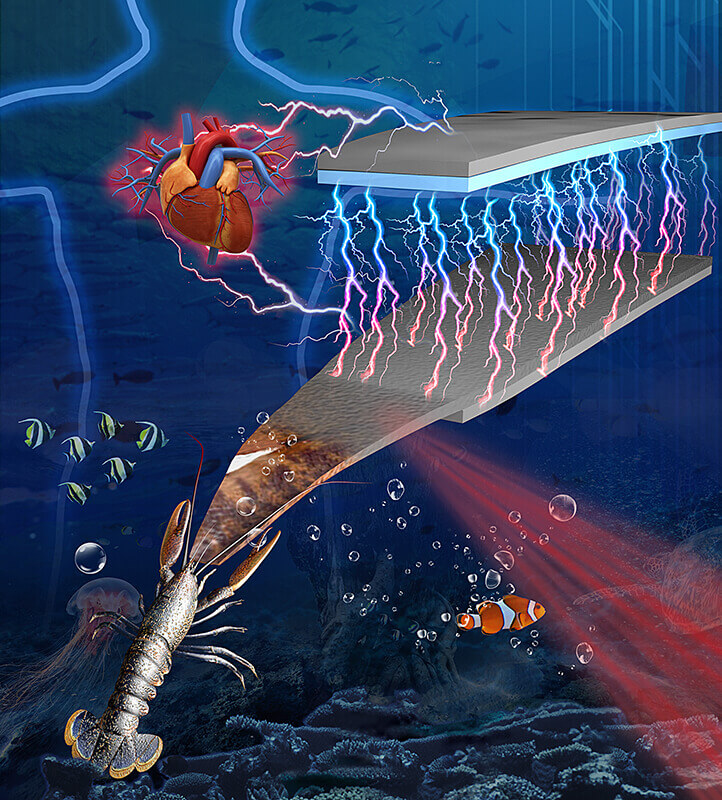April 15, 2020
Device turns shells of sea creatures into power for medical, augmented reality, cellphone devices
 A Purdue team is transforming shrimp shell material into a functional device for generating electricity. (Image provided)
Download image
A Purdue team is transforming shrimp shell material into a functional device for generating electricity. (Image provided)
Download image
WEST LAFAYETTE, Ind. – An innovation using material derived from the shells of crabs and other sea creatures may soon provide a new option for powering medical sensors, phone screens and other devices.
A team from Purdue University used chitosan – an abundant natural biopolymer from marine crustacean shells – to create triboelectric nanogenerators. TENGs help conserve mechanical energy and turn it into power.
“We have taken an innovative approach to using typically wasted shell material and turned it into functional, self-powered devices,” said Wenzhuo Wu, the Ravi and Eleanor Talwar Rising Star Assistant Professor of industrial engineering in Purdue’s College of Engineering, who led the development team.
The chitosan-based TENGs present efficient energy conversion performance and tunable biodegradation rate.
“Such a new class of TENGs derived from natural biomaterials may pave the way toward the economically viable and ecologically friendly production of flexible TENGs for self-powered nanosystems in biomedical and environmental applications,” Wu said.
Wu said the technology can be useful for medical sensors to monitor the activity of the heart or brain, or to help with touchscreen technologies on medical devices or cellphones. He said the TENG innovation also has applications for virtual and augmented reality technologies, as the Purdue innovation can detect body movement and turn the mechanical energy into electrical energy.
The team worked with the Purdue Research Foundation Office of Technology Commercialization to patent the technology. The office recently moved into the Convergence Center for Innovation and Collaboration in Discovery Park District, adjacent to the Purdue campus.
The creators are looking for partners to commercialize their technology. For more information on licensing this innovation, contact Matt Halladay of OTC at MRHalladay@prf.org and reference track code 2017-WU-67653.
The National Science Foundation provided support for part of the research. The Purdue team’s work was presented in Advanced Materials.
About Purdue Research Foundation Office of Technology Commercialization
The Purdue Research Foundation Office of Technology Commercialization operates one of the most comprehensive technology transfer programs among leading research universities in the U.S. Services provided by this office support the economic development initiatives of Purdue University and benefit the university's academic activities through commercializing, licensing and protecting Purdue intellectual property. The office is managed by the Purdue Research Foundation, which received the 2019 Innovation and Economic Prosperity Universities Award for Place from the Association of Public and Land-grant Universities. The Purdue Research Foundation is a private, nonprofit foundation created to advance the mission of Purdue University. Contact otcip@prf.org for more information.
About Purdue University
Purdue University is a top public research institution developing practical solutions to today’s toughest challenges. Ranked the No. 6 Most Innovative University in the United States by U.S. News & World Report, Purdue delivers world-changing research and out-of-this-world discovery. Committed to hands-on and online, real-world learning, Purdue offers a transformative education to all. Committed to affordability and accessibility, Purdue has frozen tuition and most fees at 2012-13 levels, enabling more students than ever to graduate debt-free. See how Purdue never stops in the persistent pursuit of the next giant leap at purdue.edu.
Writer: Chris Adam, 765-588-3341, cladam@prf.org
Source: Wenzhuo Wu, wu966@purdue.edu

